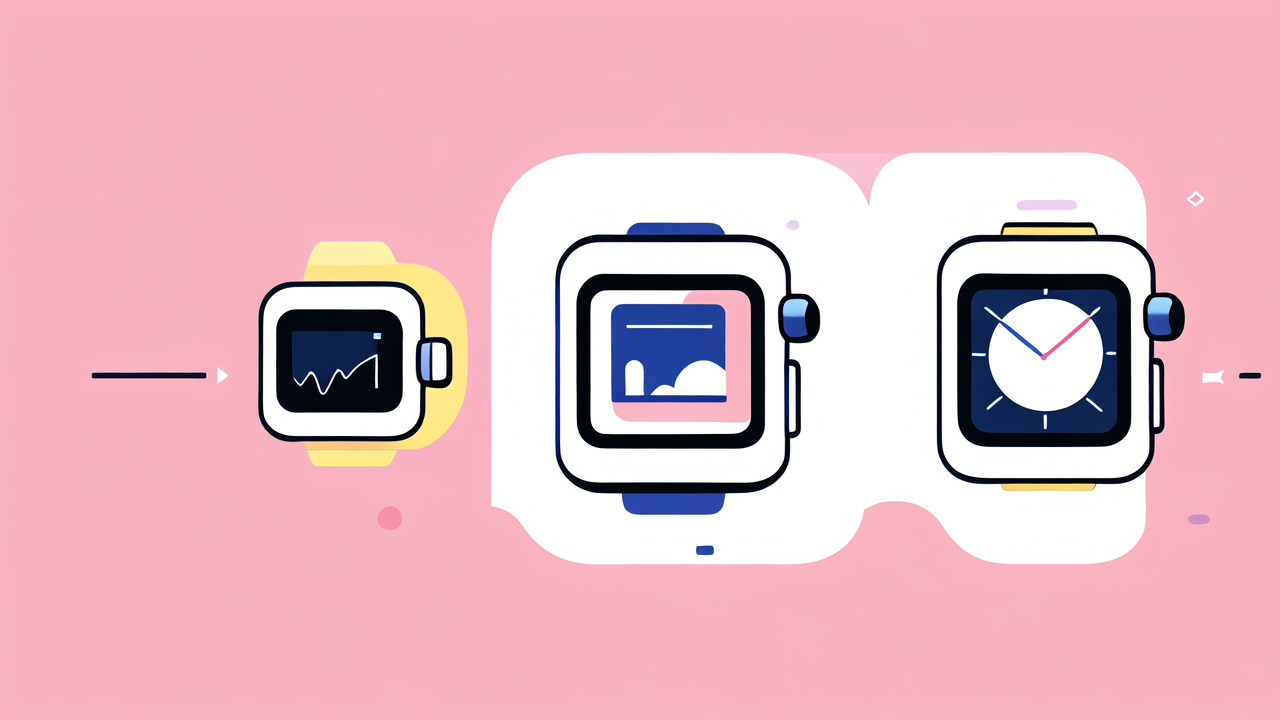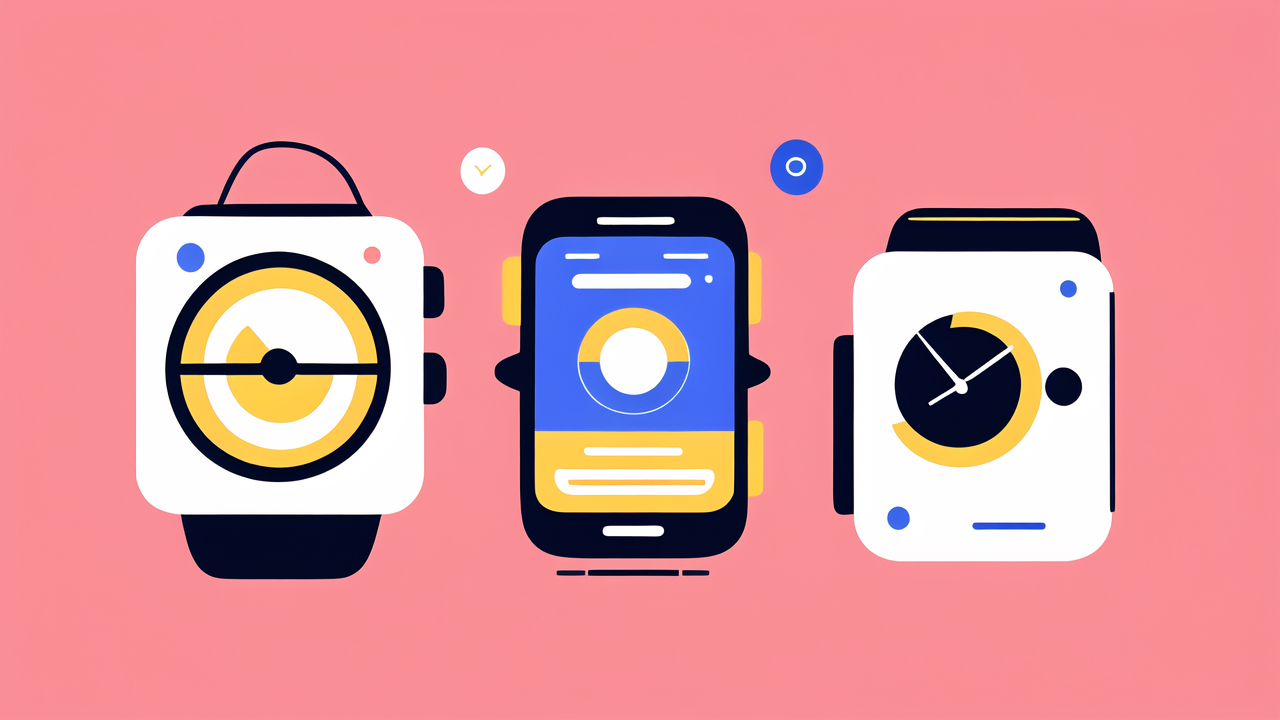The Rise of Health Monitoring Devices
The Beginnings: Pedometers and Heart Rate Monitors
Long before smartwatches became the all-in-one devices we know today, simple pedometers led the way in health monitoring. Typically clipped to a belt or waistband, these small gadgets counted steps, encouraging users to reach the recommended 10,000 daily steps for health benefits. Following pedometers, heart rate monitors became popular. Worn around the chest or wrist, these devices provided insights into cardiovascular health by tracking heart rate during rest and exercises. This early tech laid the groundwork for today's advanced health monitoring devices.

The Emergence of Smartwatches
With the demand for personal fitness insight climbing, the emergence of smartwatches marked a significant leap in health monitoring. Initially a novel gadget, smartwatches have transformed into indispensable fitness companions. Unlike their predecessors, smartwatches offer a comprehensive suite of features well beyond basic step counting. These advanced devices not only track a user's heart rate but offer a myriad of functionalities including sleep monitoring, exercise recognition, and even stress analysis. Their rise to popularity is attributed to their ease of use, where a flick of the wrist yields instant health metrics, to the delight of fitness enthusiasts and casual users alike. This integration of technology and personal health management has positioned smartwatches at the forefront of the modern health movement.
Fitness Trackers vs Smartwatches: Understanding the Differences
As health monitoring devices gain traction, it's vital to distinguish between fitness trackers and smartwatches. Fitness trackers are primarily focused on logging physical activity, including steps taken, distance covered, and calories burned. They often have a simple display and prioritize battery life. In contrast, smartwatches come with a richer set of features. They not only track fitness metrics but also offer smartphone notifications, apps, and even the ability to answer calls. Their touchscreens and sophisticated interfaces make them more versatile, though this often means a trade-off with battery life. Understanding these differences helps consumers choose the device that best fits their lifestyle and fitness goals.
Technological Advancements in Health Monitoring
Sensors and Accuracy
As health monitoring devices have evolved, the development and refinement of sensors have been central to this progression. Initially, simpler mechanisms could track basic metrics like steps taken or heart rate. Yet, as technology advanced, sensors have become increasingly sophisticated, able to capture a broad spectrum of health data with enhanced precision. Today's devices use a mix of accelerometers, gyroscopes, bioimpedance sensors, and optical sensors to provide a comprehensive review of an individual's physical condition. These advanced sensors can monitor everything from blood oxygen levels to sleep patterns, delivering accuracy that rivals some medical-grade devices. Such precision has been a game-changer, enabling individuals to gain in-depth insights into their health, paving the way for preventative healthcare measures and a more proactive approach to wellbeing.
Battery Life and Connectivity
With the rapid evolution of health monitors, one critical advancement is in the battery life and connectivity of these devices. Smartwatches now possess longer battery lifespans, enabling users to track their health data continuously without frequent charging interruptions. Enhanced battery performance is coupled with fast and stable wireless connectivity, featuring Bluetooth and Wi-Fi support. This ensures health data is synced across multiple devices and platforms effortlessly. Such improvements have bolstered the appeal of health monitoring devices, ensuring users stay connected to their fitness goals with minimal disruption. Connectivity has also expanded to include seamless integration with smartphones and a variety of health apps, allowing for a more comprehensive overview of one's health metrics.
Health Monitoring Features Over Time
Health monitoring has seen remarkable evolution, particularly in the features they offer. In the early days, simple step tracking and heart rate monitoring were considered advanced. Now, smartwatches boast a plethora of health tracking options. The introduction of sleep analysis gave users insights into their nightly patterns, helping them understand the importance of sleep for overall well-being. Over time, oxygen saturation (SpO2) monitoring became standard, allowing users to detect potential health issues earlier. Many devices now offer stress tracking by analyzing heart rate variability, which can guide users in managing their mental health.
We've also witnessed the integration of menstrual cycle tracking, encouraging a holistic approach to health for female users. Advanced workout modes that cater to various sports, from swimming to mountain biking, have also become available, reflecting the diverse needs of fitness enthusiasts. Additionally, electrocardiogram (ECG) functionality has been a game-changer, particularly for those monitoring cardiovascular health. As we move forward, the emphasis on comprehensive health data will undoubtedly drive the introduction of even more innovative features.
How Smart Watches Integrate with Fitness Regimens
Setting Goals and Tracking Progress
Smartwatches have become integral in the way individuals approach their fitness regimens. They offer a sophisticated platform to set achievable health targets and monitor advancement towards these objectives. With user-friendly interfaces, individuals can input their desired fitness goals, such as daily step count, calorie burn, or distance to run. These goals are then tracked in real-time, providing constant updates and progress reports. This dynamic interplay allows individuals to see how far they have come and how close they are to achieving their set milestones, which can be incredibly motivating. The instant feedback loop generated by smartwatches ensures that users can adapt their workouts to meet their targets more efficiently, adjusting their efforts on the fly. This aspect of health monitoring changes the game, as individuals are not just exercising blindly but are guided towards their health aspirations with precision.
The Role of Real-Time Feedback
Real-time feedback from smartwatches plays a pivotal role in fitness regimens today. As users exercise, their smartwatch continuously measures and displays key data such as heart rate, calories burned, and pace. This immediate insight allows individuals to adjust their efforts on the spot to stay within optimal training zones. For example, if the heart rate is too high during a run, the watch can alert the user to slow down, ensuring a safe and effective workout. Similarly, instant feedback on steps taken or distance covered can motivate users to push a bit further to meet daily targets. By offering this level of responsiveness, smartwatches aid in maintaining consistent performance and can significantly enhance the overall fitness experience.
Community and Social Features
Smartwatches have transcended their role as timekeepers to become hubs of social interaction. Community features on these devices encourage users to join fitness challenges, share achievements, and compete with friends, all of which serve to create a supportive network that motivates individuals to remain active. Social aspects, such as leaderboards or group tracking, foster a sense of camaraderie and accountability. With the ability to post workout summaries to social media, individuals not only celebrate their own progress but also inspire others to pursue their fitness goals. The integration of these community and social functions makes achieving personal health and fitness objectives a shared and engaging experience.
The Impact of Smart Watches on Health and Fitness
Behavioral Changes and Motivation
Smartwatches have revolutionized how individuals approach health and fitness. They incentivize users to move more and sit less by setting attainable goals and reminding them to stay active throughout the day. Monitoring steps taken, stairs climbed, and calories burned, these devices tap into the psychological principle of goal-setting, which can significantly boost motivation. Additionally, the instant feedback provided by smartwatches on daily activity levels engages users in a form of a personal game, encouraging them to beat their previous records and continuously improve. This gamified approach to fitness fosters a fun and interactive experience, transforming the often daunting task of staying fit into an enjoyable challenge. By keeping track of progress and celebrating achievements, smartwatches not only fuel a competitive spirit within individuals but also cultivate a habit of regular exercise, aiding them in building a healthier lifestyle incrementally.
Quantified Self-Trend and Self-Improvement
The 'Quantified Self' movement has gained momentum with the rise of smartwatches, encouraging individuals to track their personal data in pursuit of self-improvement. These wearable devices offer a myriad of sensors that collect health metrics such as steps taken, heart rate, sleep quality, and more. People use this data to identify patterns, set health goals, and make informed decisions about their fitness routines. As users continuously monitor their physical activity and vital signs, they become more mindful of their habits and can adjust their behaviors accordingly. This self-awareness often leads to improved health outcomes, increased physical activity, and a more proactive approach to wellness. Smartwatches have not only enabled more precise health tracking but also have become a cornerstone for many in their journey of personal growth and healthier living.
Long-term Health Benefits
Smartwatches have transformed how we engage with our health, offering more than just short-term feedback. Over time, they deliver substantial long-term health benefits. Regular use of these devices encourages users to adopt healthier lifestyles. As individuals monitor their daily activity levels, sleep patterns, and even stress levels, they become more conscious of their well-being. This awareness often leads to better eating habits, increased physical activity, and improved sleep hygiene. Moreover, smartwatches can help detect early signs of health issues such as irregular heart rates, aiding in early intervention. Long-term, users may experience reduced risks of chronic diseases, better weight management, and enhanced overall wellness. The benefits are clear: smartwatches offer a powerful incentive for individuals to take charge of their fitness journey, contributing positively to their long-term health.
Popular Smart Watch Brands in Health and Fitness
Pioneers in Health Monitoring
The landscape of health monitoring has seen significant contributions from several key players. Brands like Apple, Garmin, and Fitbit are widely recognized as pioneers in this space. Apple's launch of the Apple Watch set a new standard for what a smartwatch could do, integrating comprehensive health tracking with connectivity and style. Garmin, known for its precision GPS technology, advanced the field with devices tailored for serious athletes and outdoor enthusiasts. Meanwhile, Fitbit made fitness tracking accessible to the masses, introducing user-friendly devices that monitor daily activity, sleep, and exercise. Each brand has played a vital role in advancing the integration of health monitoring devices into our daily lives, setting the stage for future innovations in the realm of personal health and fitness.
Comparative Analysis: Features and Functionalities
When exploring the crowded market of health-focused wearables, it's imperative to consider how various smartwatch brands stack up regarding features and functionalities. Let's compare some leading names in the space.
Apple Watch: Renowned for its comprehensive health features including heart rate monitoring, ECG capabilities, and oxygen saturation detection. Integration with iOS devices provides a seamless user experience.
Fitbit: Known for its robust fitness tracking, sleep monitoring, and long battery life, Fitbit offers a user-friendly dashboard to assess health data.
Garmin: Appeals to serious athletes with its advanced performance metrics, GPS tracking, and recovery advice. Our comparison highlights Garmin's unique focus on outdoor activity precision.
Samsung Galaxy Watch: Includes stress management tools, automatic workout detection, and has a noteworthy partnership with popular health apps for a holistic health approach.
Withings: Stands out with medically-oriented features such as blood pressure monitoring and a more traditional watch aesthetic that houses a range of health functionalities.
Assessing these brands reveals a spectrum of options catering to different health and fitness needs, with each brand carving out a niche based on its particular strengths in monitoring capabilities.
Privacy and Security Concerns
Data Handling and User Privacy
As smartwatches and fitness trackers become ubiquitous, concerns about how these devices handle user data are growing. These gadgets collect a vast amount of personal health information, from heart rate patterns to sleep quality, steps taken, and even location. Ensuring that this sensitive data is securely stored and transmitted is paramount. Users should have control over who can access their information, and companies must be transparent about their data practices. Strong encryption methods, secure cloud services, and user consent protocols are essential components of user privacy in the age of wearable health monitors. It's vital that users familiarize themselves with privacy settings and terms of service to protect their personal health data against unauthorized use.
Regulatory Landscape and Standards
The regulatory landscape surrounding health monitoring devices is becoming increasingly important as these gadgets become more embedded in our daily lives. Regulatory bodies across the globe are implementing standards to ensure the privacy and security of user data. These include the General Data Protection Regulation (GDPR) in the European Union, which sets a precedent for data protection worldwide. In the US, the Health Insurance Portability and Accountability Act (HIPAA) governs the use and disclosure of personal health information. Additionally, many countries are adopting specific standards for health devices, like the ISO/IEEE 11073 standards for device interoperability in healthcare settings. These regulations are crucial in fostering consumer trust and enabling the safe, ethical use of health monitoring technologies.
The Future of Health Monitoring
Predictive Analytics and Personalized Health
With innovative strides in technology, the future of health monitoring shines bright with predictive analytics leading the charge. This advanced technology helps personalize health regimens by analyzing data over time to forecast potential health issues before they arise. Smartwatches, with their ability to track multiple health metrics, are on the brink of using complex algorithms to provide users with predictions about their health risks and offer tailored advice for prevention and care. This proactive approach empowers individuals to make informed decisions about their health, promoting a move from reactive to preventative healthcare. The integration of these analytics into everyday wearables signifies a major leap towards customizing fitness and health plans, making them as unique as the individuals using them.
Innovations on the Horizon
As health monitoring technology continues to evolve, several cutting-edge innovations are setting the stage for a future where health management is more integrated and intuitive than ever before. Companies are working on next-generation smartwatches that may feature non-invasive blood glucose monitoring, allowing diabetics to keep track of their sugar levels without the need for painful and intrusive finger-pricks. Advancements in materials science may lead to more durable and skin-friendly wearables that can be worn continuously. Another exciting prospect is the integration of AI-driven diagnostics, which can potentially alert users to health issues before they become critical. AI could provide personalized health assessments and recommend lifestyle changes or doctor visits when necessary. Enhanced biometric tracking is also anticipated, improving the accuracy and range of health metrics measured. These innovations promise a new era in health monitoring where convenience, precision, and early intervention pave the way to better overall health outcomes.
Integration with Healthcare Systems
As health monitoring technology advances, the integration of smartwatches with healthcare systems is becoming a pivotal development. These devices are increasingly playing a critical role not just in individual fitness tracking but also in patient care and medical research. For instance, some smartwatches can now send real-time health data to physicians, allowing for remote monitoring of chronic conditions like heart disease. This seamless flow of information can lead to more personalized treatment plans and quicker healthcare responses. Hospitals and clinics are also starting to utilize the data collected from health monitors for large-scale studies, which can lead to breakthroughs in understanding various health conditions. Furthermore, these integrations aim to reduce the overall strain on healthcare systems by empowering individuals to take charge of their health proactively with the support of technology. As privacy concerns are addressed, the future of health monitoring is set on a course of deeper integration, where technology and healthcare systems work hand in hand for improved health outcomes.




Leave a comment
This site is protected by hCaptcha and the hCaptcha Privacy Policy and Terms of Service apply.